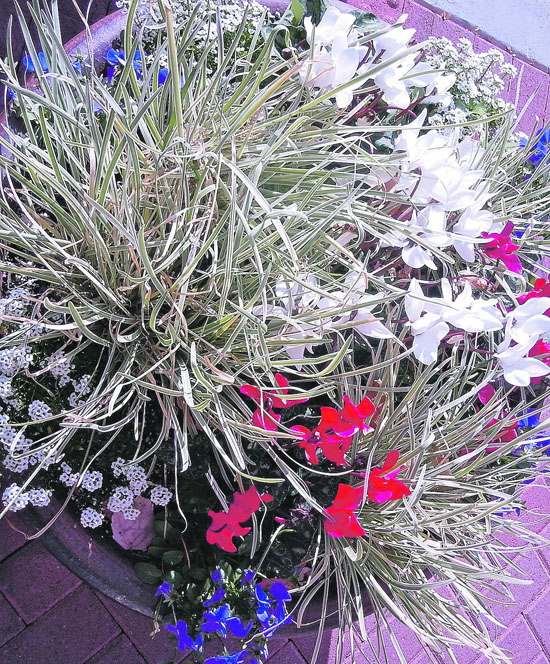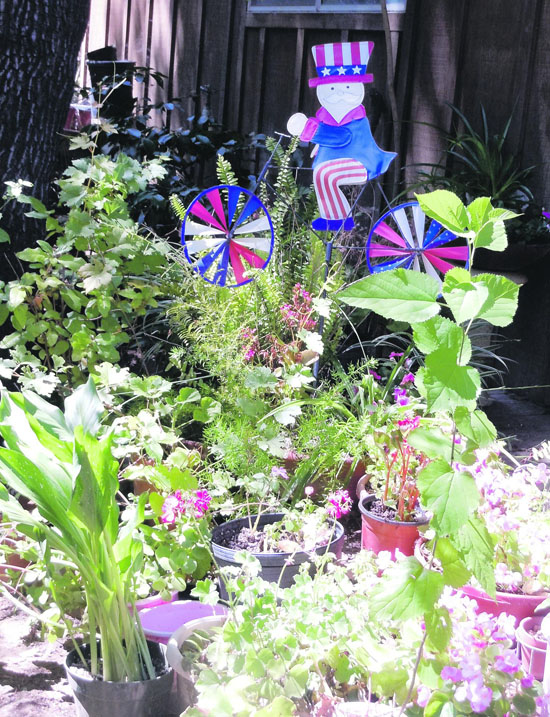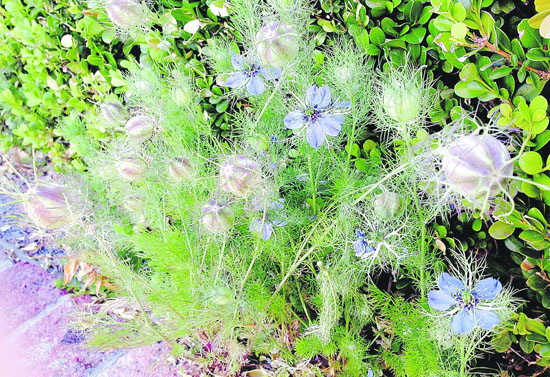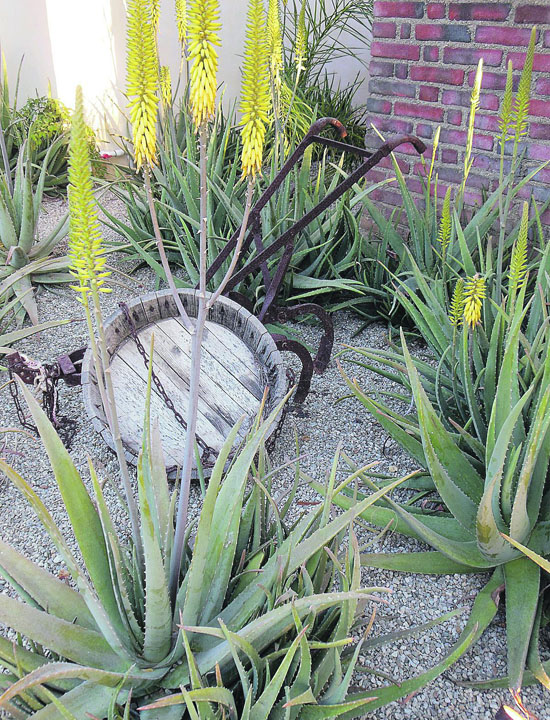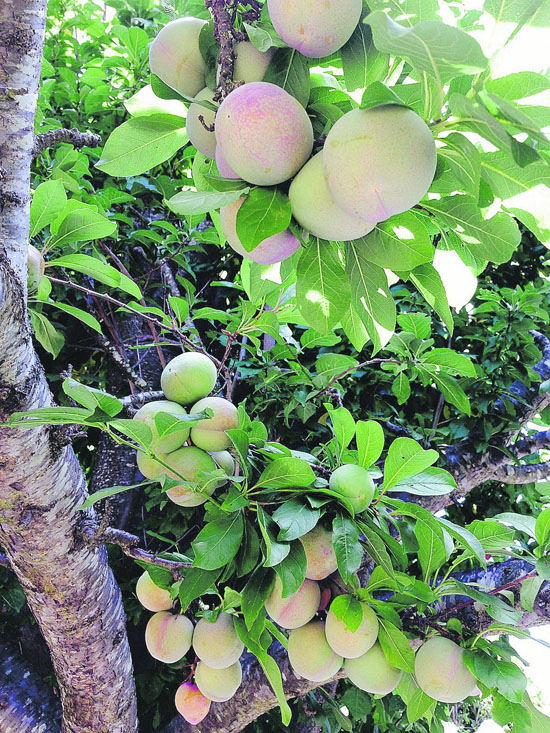 |
|
|
Thin the fruit on your tress. Santa Rosa plums are ripening but the large crop could break the limbs. Photos Cynthia Brian
|
|
|
|
|
|
Summer is here in its full glory with the Fourth of July promise of parades, pancake breakfasts, barbecues, fireworks, and family fun. Our dry hills glisten golden while water conservation is the talk of the town. The warm winter allowed fruit trees to burst into bloom only to have the blossoms knocked to the ground by a late rain. Ripening fruit is sparse, if nonexistent, except for certain varieties. My experiment of early vegetable planting in April resulted in plants that didn’t survive the acute climate changes. Despite this dismal failure, I’m glad I attempted the unexpected. Next spring I’ll wait until the optimum moment to transplant seedlings. On the positive side, plants that froze have recovered and are thriving. Other than straightforward yard maintenance, July is relatively labor-free since we’ve already done all the really hard work in preparation for the season. Sit on the patio, pour yourself a cold one, and enjoy living in the land of the free.
• RETHINK summer beverages by making your own flavored waters with fruits and herbs from your garden. Add mint, cucumbers, tangerines, basil, and berries to your favorite cocktail for a splash of sunshine.
• REMOVE your lawn and replace it with an East Bay Municipal Utility District sustainable landscape option and you’ll qualify for a rebate of 50 cents per square foot of grass removed. Call (866) 403-2683 to schedule an appointment.
• CONSERVE moisture by adding 2-3 inches of mulch to your landscape if you haven’t already. Visit www.EBMUD.com for discount coupons on purchasing mulch.
• WATER early in the morning or evening to eliminate evaporation and water deeply yet infrequently. It’s hot and deep watering encourages a deeper root system.
• SOAK tree roots with a deep soaker. While lawns will come back if they are not watered, your trees will die without H20. Buy a deep soaker rod and use it.
• LINGER on a bench at the beach, in your garden, or at the park to enjoy the scenery.
• GROW your own vegetables, fruits, and herbs and be water-wise. Home gardeners use 1/4 to 1/8 less water than commercial growers for the same produce.
• ADD straw to beds as an excellent covering that provides a habitat for beneficial microbes while keeping the soil moist.
• THIN apricots, peaches, pears, apples, and lemons on your trees to allow for a tastier, larger fruit harvest when ripe.
• PROPAGATE herbs such as lovage and lemon grass and edible flowers like nasturtiums and calendula for a perennial party of exotic flavors.
• INCREASE the amount of sunscreen you use while in the garden. Make sure to re-apply often, wear a hat, and sunglasses to protect your eyes.
• EAT fresh organic eggs as eggs currently sold in supermarkets are nutritionally inferior to eggs produced by hens raised on pasture. Testing has found that, compared to official U.S. Department of Agriculture nutrient data for commercial eggs, eggs from hens raised on pasture contain 1/3 less cholesterol, 1/4 less saturated fat, 2/3 more vitamin A, two times more omega-3 fatty acids, three times more vitamins, and seven times more beta carotene.
• CLEAR debris, leaves, limbs, dead grass, wood, reeds, and all flammable materials from around the perimeter of your home. Fire danger is high all summer.
• PREPARE to pay more for fresh produce at your local grocer and farmers’ market if you haven’t grown your own.
• SPRINKLE Growstone’s Gnat Nix®, a non-toxic, chemical-free fungus gnat control top dressing made from recycled landfill glass on the surface of your containers and beds to reduce gnats on plants, indoors and out. www.growstone.com.
• VOLUNTEER in a city or community garden even if you are not a gardener. Research indicates that even a little digging in the dirt boosts serotonin levels and decreases depression.
• LEARN from your mistakes. Don’t get frazzled when something you planted doesn’t grow in a particular spot. Plants wither and die. Plant something else.
• CUT back alliums after they are dry to encourage new growth and naturalization.
• CHECK yourself for ticks every time you come in from the outdoors. Ticks will jump on your body during hiking, gardening, or just strolling. (I’ve had four hitchhike so far this season!)
• WALK around your garden daily to observe what is new, what needs attention, and to admire your artistry.
• DECORATE for Independence Day by filling containers with the colors of our flag. Red and white cyclamen, blue lobelia, white perennial alyssum paired with variegated society garlic makes a festive moveable display.
• NAP in the shade. You deserve a break today.
Wishing you a fabulous Fourth of July with family and friends. Be safe, be wild, be free! Happy gardening and happy growing!

|

